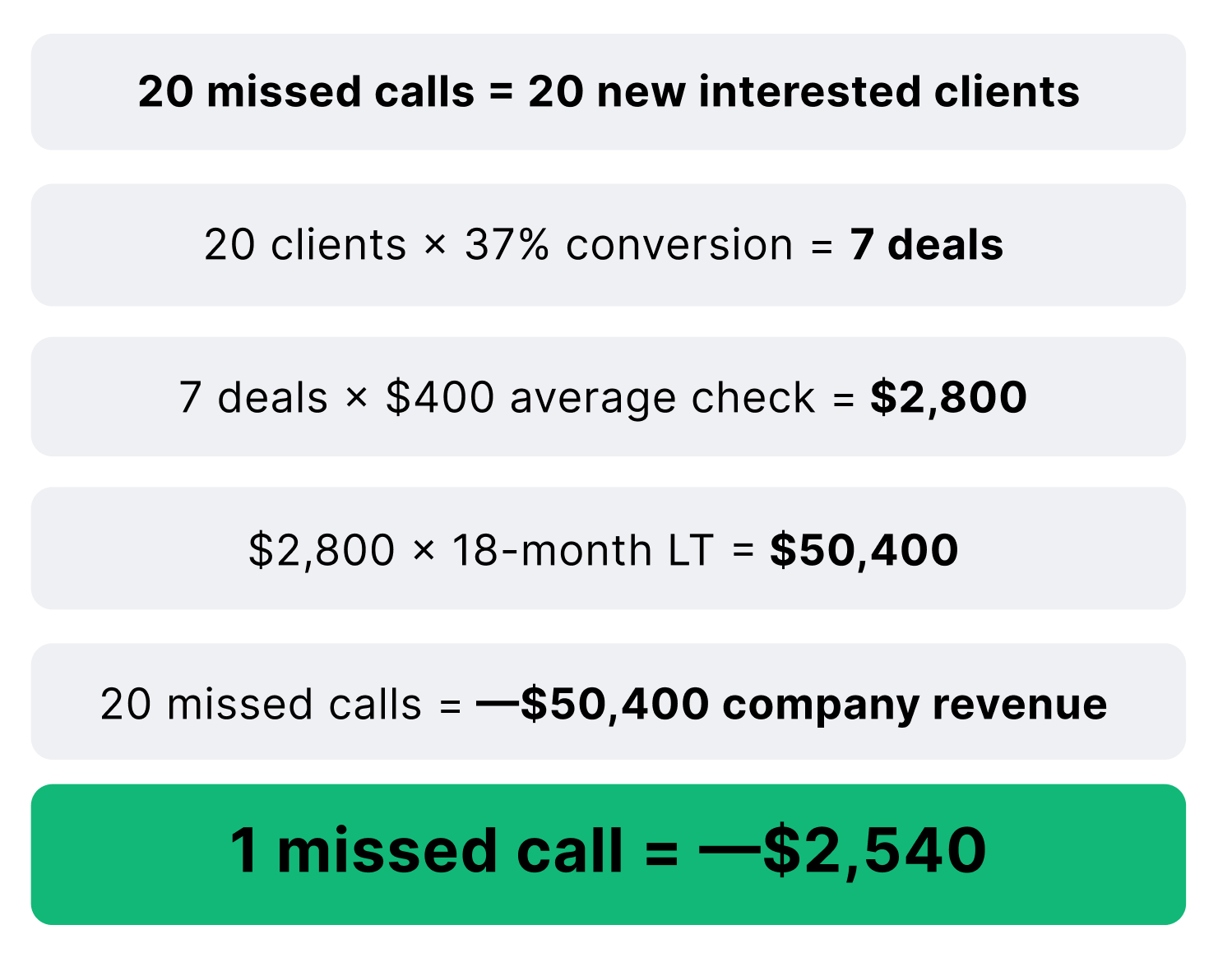Imagine $2,800 disappearing from your corporate account every day — without any documentation or reports. You’d call security and launch an investigation, wouldn’t you? In reality, that’s exactly how much each missed customer call costs on average when you factor in not just the lost deal, but all future purchases from that customer. It’s time to stop ignoring these invisible losses and start calculating the true cost of every missed call.
Hidden Losses from Missed Calls
Every unanswered call triggers a cascade of financial losses that spread far beyond what’s immediately visible.
Direct Losses: Sales Lost Here and Now
The obvious loss — the visible tip of the iceberg — is the specific deal you lost right now. According to statistics, 85% of customers who can’t reach a company won’t try calling again — they simply go to competitors.
But even these apparent losses often go unnoticed. Most companies don’t have a system for tracking missed calls. CRM systems only store deals that entered the funnel, but they don’t show potential buyers who never had a chance to get there because of an unanswered call.
Indirect Losses: Reputation Threats
What happens after a missed call is equally dangerous. According to research, 13% of customers with negative experiences tell others about it. Thanks to social media and online review platforms, one missed call can cost you dozens of potential buyers. Meanwhile, you won’t even know there’s a problem — out of 26 dissatisfied customers, only one will complain to you directly. The rest will silently go to competitors, leaving you unaware of the problem’s true scope.
Additional Costs: Marketing Budgets Thrown Away
Every incoming call is the result of your investments and your marketing team’s work. Pay-per-click advertising, SEO, social media, PR — all possible resources and tools were used to help that customer find and dial your phone number. When a call goes unanswered, all those investments are wasted.
According to statistics, acquiring a new customer costs 5-25 times more than retaining an existing one. Therefore, every missed call isn’t just a lost deal — it’s also wasted advertising budget that needs to be spent again to attract another customer.
Long-term Consequences: Why One Missed Call Costs More Than It Seems
What’s also striking is the realization that you’re not just losing one deal, but all future purchases from that customer.

Let’s say your managers miss 20 calls daily — this is fairly typical for an average company, and at first glance, these numbers don’t seem critical. But let’s do the math.
Those 20 missed calls represent 20 interested customers who went through the entire journey — from Google search to studying your website, comparing with competitors, and deciding in your favor. With an average conversion rate from incoming calls to sales of 37%, 7 out of these 20 potential customers would definitely become your buyers. Seven deals at an average check of $400 equals $2,800 in direct losses per day. That’s substantial.
But the real pain begins when you factor in the customer lifecycle. These seven customers could not only buy once — they could return over the next 18 months, spending $2,800 each time. Therefore, 20 missed calls don’t cost you $2,800, but a full $50,400 in lost revenue gifted to competitors.

Remote and Hybrid Work: Additional Challenges
Loss of Direct Team Control
The war in Ukraine has changed familiar business processes. Some employees work remotely from abroad, others work from home between air raid alerts. If previously a manager could physically see what was happening in the office — who was talking to customers, who was free, how many phones were ringing simultaneously, who was having difficulties with a “problematic” caller — now this is impossible.
Previously, a missed call in the office was noticeable — the phone rang, but no one picked up. But now these losses have become completely hidden. A manager might not answer calls due to power outages, poor internet, air raid alerts, and the manager won’t know about it without special monitoring tools. Or they might accidentally find out only hours or even days later, when the customer has already gone to competitors.
The result — managers have lost the ability to directly observe, help, advise, and quickly intervene in their team’s work.
Difficulty Coordinating a Distributed Team
Previously, transferring a customer between departments happened across the office hallway in 30 seconds. Now it requires messengers and emails, plus procedures for synchronizing between employees as outlined in regulations. Context gets lost in these processes, response speed suffers. Sometimes customers are forced to repeat their requests or explain their needs to several different employees.
Meanwhile, 72% of customers say that explaining their problems to multiple people is poor service. In distributed work conditions, the risk of such customer “bouncing” between employees increases exponentially.

Loss of Corporate Standards
Another dangerous consequence of the new reality is the loss of a unified brand voice. A manager in Kyiv might tell customers one thing about services, while their colleague in Krakow tells them something completely different. Without constant live communication, under stress and constant changes, employees begin improvising and deviating from established standards.

How to Minimize Losses from Missed Calls
Fighting missed calls requires a comprehensive approach. It’s not enough to simply buy new software or hire more managers — you need to rethink the entire customer service process.
Automation: The Foundation of Control
The first element is maximum process automation. Every call should be automatically logged in the telephony system, and even better — also transferred to the CRM system with complete information: who called, when they called, how long they had to wait for an answer, who answered, how long the conversation lasted. Without such basic data, a manager can’t assess the scope of the problem.
Modern technologies allow integrating telephony with CRM systems so that every call automatically creates a new contact and task for the manager. For example, if a call is missed, this becomes a “Call back” task. All missed calls also instantly appear in management reports.
Communication Standardization
The next component is clear standards and scripts for all customer communication scenarios. This doesn’t mean turning managers into robots, but rather creating a framework within which they can demonstrate their professionalism, intuition, and charisma.
It’s also important to regularly analyze communication by listening to call recordings and reviewing call reports to monitor whether managers are following scripts. Update scripts and standards as needed based on analysis of daily customer conversations.
Constant Monitoring
Finally, building a real-time team monitoring system is important. Modern telephony systems allow setting up reporting and instant notifications about current communication status: which employees are currently talking, how many calls are waiting in queue, if there are missed calls requiring immediate attention.
This allows managers to quickly redistribute workload, connect additional staff, or even personally handle the most important calls when necessary.
Team Responsibility
Every employee must understand that a missed call isn’t just a minor, insignificant mistake, but real losses for the company. When someone knows and remembers that one unanswered call costs the company $2,800, their attitude toward work changes.
However, it’s important not to create an atmosphere of total control in the team. When employees understand that their quick response helps the entire company achieve shared success, this creates much stronger motivation than fear of punishment. Create team spirit around a common goal — no customer should be left without an answer.
Employees who achieve the best call handling metrics should feel recognized and receive additional motivation through bonuses and career advancement opportunities.
Share successes and learn from mistakes together — this way you’ll create an environment where every call becomes a priority for the team.
Practical Steps for Managers
Theoretical understanding of the problem is just the beginning. Real change starts with concrete actions that managers can implement tomorrow.
Step 1: Audit Current State
First, you need to understand the real scope of the problem. Often managers don’t know the exact number of missed calls in their company. After connecting modern telephony and getting real numbers, most experience genuine shock.
Look at the total number of incoming calls for the last month and determine how many went unanswered. It’s also important to calculate the average call response time and assess how many customers called back after a missed call — this will show how actively people try to reach you.
Also analyze each employee’s efficiency. Sometimes workload is distributed unevenly in the team — some overwork to the point of burnout, while others avoid even basic responsibilities.
This basic analytics will give you numbers for further loss calculations. Use the formula from the previous section to convert the number of missed calls into monetary equivalent.
Step 2: Key Metrics for Daily Control
Establish clear indicators that your team will track daily, for example:
- missed call percentage: less than 10%;
- average response time: 15 seconds;
- number of callbacks for missed calls: 100% within an hour.

Step 3: Action Plan to Minimize Losses
Not all problems need equal attention. Focus on changes that will deliver maximum results with minimal investment:
Urgent Measures
- Implementing simple KPIs in employees’ daily work. Start tracking basic metrics for each employee: how many calls were missed per day, average response time, percentage of callbacks for missed calls.
- Team training. Hold a series of meetings where you show the team the calculation of missed call costs and explain why response speed is critically important for shared success.
Medium-term Improvements
- Schedule optimization. Analyze what time most calls come in and adjust your team’s working hours to these peaks.
- Call forwarding system. Set up rules so calls are automatically directed between managers in parallel or sequence, ensuring that even if someone is busy, requests don’t go unanswered.
- Communication standards and scripts. Describe how to communicate with customers in different situations so the business speaks to all customers with “one voice.”
Long-term Solutions
- Telephony-CRM integration. Set up the connection between systems so every call is automatically transferred to CRM, contact data is saved, conversations are recorded in communication history, and appropriate tasks are created for employees.
- Automated analytics. Set up a telephony system that generates reports on missed calls and manager efficiency. Modern telephony systems like Ringostat provide even detailed AI reports analyzing each conversation, down to minor manager mistakes, script adherence quality, and recommendations for next steps to close deals.
- Staff training system. Create a continuous process for improving team skills based on recordings and analysis of real conversations.
Conclusions
- Missed calls cost much more than they seem. One unanswered call can cost a company $2,800, considering the entire lifecycle of the lost customer and the cascading effect of reputation losses.
- Remote work for Ukrainian businesses under current conditions has created new challenges. Managers have lost direct control over their teams, and task coordination between employees has become more difficult.
- The problem requires a systematic approach. It’s not enough to simply buy new equipment; comprehensive automation, communication standardization, constant process monitoring, and corporate culture change are needed.
- Implementation of new tools and approaches should happen in stages — from urgent measures like developing KPI systems to medium-term and long-term solutions for optimizing work schedules, setting up call forwarding, integrating telephony with CRM, and automating processes.

